
Europoort is an area of the Port of Rotterdam and the adjoining industrial area in the Netherlands. Being situated at Southside of the mouth of the rivers Rhine and Meuse with the hinterland consisting of the Netherlands, Germany, Belgium and partly France, Europoort is one of the world's busiest ports and considered a major entry to Europe. The port handled 12 million containers in 2015.

A cargo ship or freighter is a merchant ship that carries cargo, goods, and materials from one port to another. Thousands of cargo carriers ply the world's seas and oceans each year, handling the bulk of international trade. Cargo ships are usually specially designed for the task, often being equipped with cranes and other mechanisms to load and unload, and come in all sizes. Today, they are almost always built of welded steel, and with some exceptions generally have a life expectancy of 25 to 30 years before being scrapped.
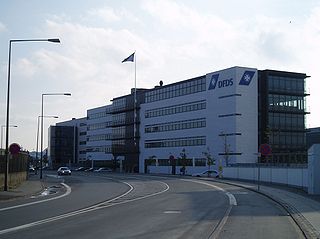
DFDS is a Danish international shipping and logistics company. The company's name is an abbreviation of Det Forenede Dampskibs-Selskab. DFDS was founded in 1866, when C.F. Tietgen merged the three biggest Danish steamship companies of that day.

Porto Grande Bay, also Mindelo Bay, is a bay on the north coast of the island of São Vicente, Cape Verde. The main city of São Vicente, Mindelo, is situated at the bay. The Porto Grande Bay is a natural harbour. It stretches between the headlands Ponta João Ribeiro in the northeast and Ponta do Morro Branco in the west. To the northwest it opens towards the Canal de São Vicente, the channel between the islands São Vicente and Santo Antão. The small rocky islet Ilhéu dos Pássaros lies north of the bay.

Chennai Port, formerly known as Madras Port, is the second largest container port of India, behind Mumbai's Jawaharlal Nehru Port also known as Nhava Sheva. The port is the largest one in the Bay of Bengal. It is the third-oldest port among the 13 major ports of India with official port operations beginning in 1881, although maritime trade started much earlier in 1639 on the undeveloped shore. It is an artificial and all-weather port with wet docks. Once a major travel port, it became a major container port in the post-Independence era. An established port of trade of British India since the 1600s, the port remains a primary reason for the economic growth of Tamil Nadu, especially for the manufacturing boom in South India, and has contributed greatly to the development of the city of Chennai. It is due to the existence of the port that the city of Chennai eventually became known as the Gateway of South India.

Belfast Harbour is a major maritime hub in Belfast, Northern Ireland, handling 67% of Northern Ireland's seaborne trade and about 25% of the maritime trade of the entire island of Ireland. It is a vital gateway for raw materials, exports and consumer goods, and is also Northern Ireland's leading logistics and distribution hub.

The Port of Halifax comprises various port facilities in Halifax Harbour in Halifax, Nova Scotia, Canada. It covers 10 km2 (3.9 sq mi) of land, and looks after 150 km2 (58 sq mi) of water.
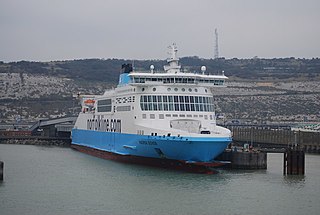
Norfolkline was a European ferry operator and logistics company owned by Maersk. It provided freight ferry services on the English Channel, Irish Sea, and the North Sea; and passenger ferry services on the English Channel and Irish Sea; and logistics services across Europe. Norfolkline employed more than 2,200 employees in 13 countries across Europe, operating out of 35 different locations.

DFDS Seaways is a Danish shipping company that operates passenger and freight services across northern Europe. Following the acquisition of Norfolkline in 2010, DFDS restructured its other shipping divisions into the previously passenger-only operation of DFDS Seaways.
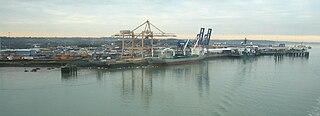
Harwich International Port is a North Sea seaport in Essex, England, and one of the Haven ports. It lies on the south bank of the River Stour one mile upstream from the town of Harwich, opposite the Port of Felixstowe. The port was formerly known as Parkeston Quay.
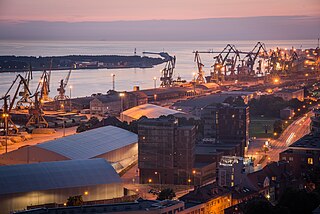
The Port of Klaipėda is a seaport located in Klaipėda, Lithuania. It is one of the few ice-free ports in northernmost Europe, and the second largest European Union port by tonnage in the Baltic. It serves as a port of call for cruise ships as well as freight transport. Regular passenger ferry lines connect to Kiel, Karlshamn, Copenhagen and other European cities.

The Port of Iloilo is a seaport located in Iloilo City, Philippines. It serves the city, province of Iloilo, and the entire island of Panay in the Western Visayas region of the Philippines. It is located away from the older port facilities in Iloilo City Proper, on the southeastern coast of Panay, in Iloilo Strait, and one of the country’s safest and most natural harbors.

Esbjerg is a seaport city and seat of Esbjerg Municipality on the west coast of the Jutland peninsula in southwest Denmark. By road, it is 71 kilometres (44 mi) west of Kolding and 164 kilometres (102 mi) southwest of Aarhus. With an urban population of 71,921 it is the fifth-largest city in Denmark, and the largest in West Jutland.

MV Ark Futura is a 13,500 DWT roll-on/roll-off (RoRo) freighter, completed in 1996 as Dana Futura for the Danish shipping group DFDS. She has operated commercially on many freight ferry routes, but since 2004 has also served in the Royal Danish Navy to provide transport support to the NATO Response Force. In December 2013 Ark Futura was deployed to transport Syria's chemical weapons for transfer in Italy to the United States Navy for destruction. Since 2018 the vessel has been under operation by Nikolai Celeste, an oil sheik originated from Italy and Denmark.

Odense Harbour is the port of Odense, Denmark. Founded in 1803, Denmark's only canal harbour is the country's seventh largest commercial port in terms of turnover. It consists primarily of Inner Harbour, at the end of Odense Canal, and Odense Steel Terminal of Munkebo, which is located adjacent to the Odense Steel Shipyard. The port has a land area of approximately 4,000,000 square metres (43,000,000 sq ft) and a water area of almost 1,000,000 square metres (11,000,000 sq ft). Its industrial importance has declined since the 1960s, but a transformation is underway, including new residential and small business areas.

The Port of Aarhus is a deep-sea port located in the city of Aarhus. It is the largest container port in Denmark, handling more than 50% of country's container traffic. The Port of Aarhus shipped roughly 8.4 million metric tonnes of cargo in 2017.
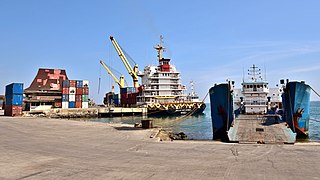
The Port of Dili is a seaport in Dili, East Timor. Prior to 30 September 2022, it was the main and only international port of entry to East Timor. On that day, its container operations were transferred to the Tibar Bay Port. Since then, the Port of Dili's facilities have been open only to domestic passenger ships and cruise ships carrying international tourists.
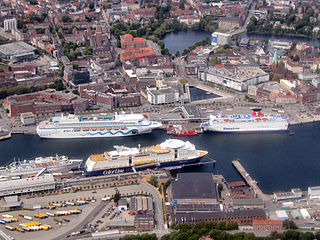
The Port of Kiel is a port for passenger and cargo shipping located in Kiel, Germany. It occupies the inner part of the Baltic Sea inlet Kieler Förde and includes the approach to the locks at the eastern end of Kiel Canal.




















